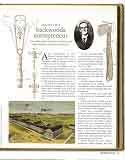Legacy of a Backwoods Entrepreneur

By Dianna Stampfler
A true Midwesterner at heart, Webster Lansing Marble was raised in the woods, becoming an expert woodsman, hunter and trapper. After moving to Michigan with his family as a teenager, he found a career as a surveyor and timber cruiser, scouting land for companies. An inventor by nature, his time working the land lead to the development of new, innovative equipment that would be both practical and durable in the outdoors.
As a family man, Marble trekked north and landed in Glastone in Michigan’s rustic Upper Peninsula. By the end of the 20th century, the man would later hold more than 60 patents had invented the “Universal Rifle Sight” and incorporated Gladstone Manufacturing Company. Unfortunately, the “Panic of 1893” and the recession that followed halted operations. Not to be deterred, the ambitious entrepreneur founded the Marble Safety Axe Company in 1898.
Among his most noted tools are the “Safety Pocket Axe” which is still widely sold today, and features a guard that folds into the handle. His “Ideal Knife” became the prototype for all sporting and military knives through World War II; it was recently re-introduced after a 50-year absence. The “Game Getter” was a pistol, with a folding stock that transformed it into a shotgun or rifle. Marble hunting and fishing knives, waterproof metal matchboxes and compasses were carried by nearly every hunter, soldier and Boy Scout in America for decades.
Marble was a calculated marketer as well, selling the dream as much as the brand. He used ad coding, celebrity endorsements, promotional incentives and other strategies that launched him into the world of outdoor gear. In 1899, he even traveled to from the UP to New York City to exhibit at the Sports Expo at Madison Square Garden. Marble also relied on mail-order advertising, using slightly different addresses for each publication so he was able to track which gave him the best return on investment.
With this shift in lifestyle, Marble became the go-to outdoor recreational supply company, both here and abroad. Marble outfitted millions of hunters, anglers, campers and hikers, as well as the world’s most noted outdoorsmen and adventurers during the early 20th Century.
In 1913, former president Teddy Roosevelt carried Marble compasses during his Expandicao Scientifica exploration of Brazilian wilderness; arctic expedition leader Robert Peary used Marble gear during his 1909 trek to the North Pole; and aviator, explorer and fellow entrepreneur Charles Lindberg carried a Marble knife,
compass and matchbox on his first solo transatlantic flight in 1927. These items are no on display at the Smithsonian.
Marble’s rich history is explored in the “Inventing the Outdoors” exhibit on display through September 11 at the Michigan Historical Museum in downtown Lansing. Visitors will find the famed safety folding axes, hunting knives, automatic fish gaffs and more. The exhibit also takes a look at how we experience the outdoors and the origins of our desire for outdoor recreation, through the life of this remarkable Michigan inventor—who was inducted posthumously into the Sporting Goods Industry Hall of Fame in 1965.
Marble Arms still operates in Gladstone, employing about 30 people who produce iron gun sites. Marble’s Outlet Store is an independent retailer offering a full-line of Marble products, including many knives not often found elsewhere.
